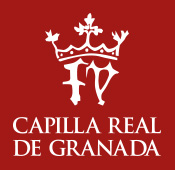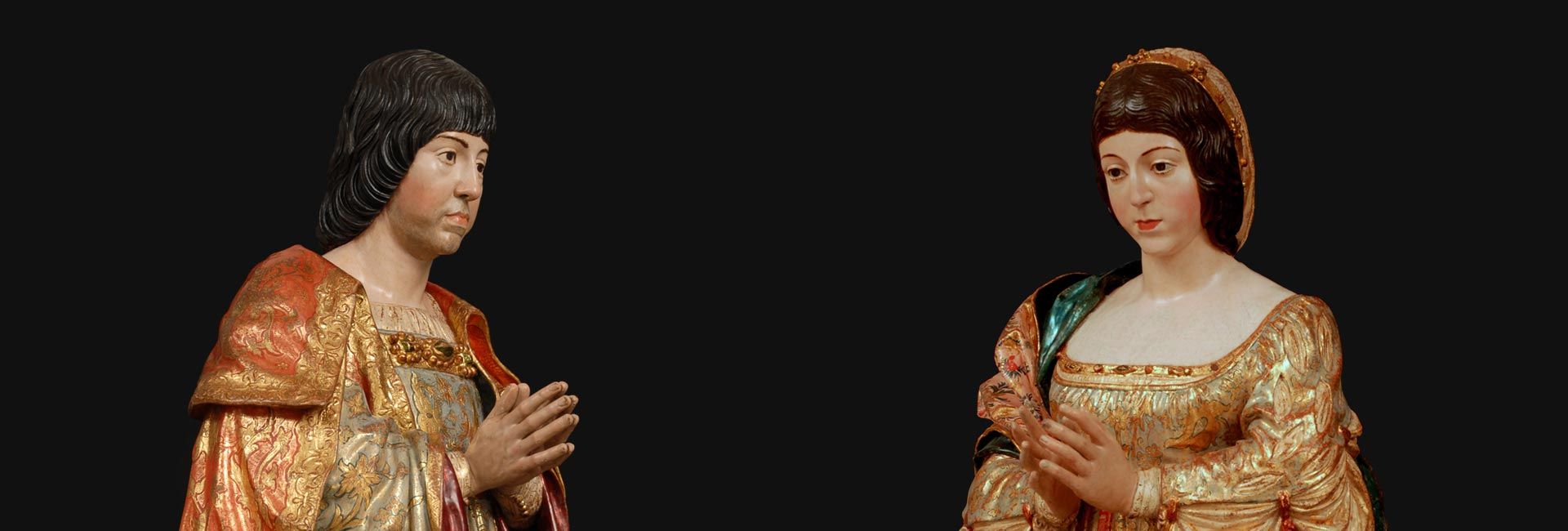The Royal Chapel of Granada houses the mortal remains of Isabella I of Castile and Ferdinand V of Aragon, called the Catholic Kings. It also houses the remains of their heirs, Joanna I and Philip I. Finally, we also find the remains of Prince Michael, who died in Granada aged 2 in 1500. During his short life, he was heir to the thrones of Spain and Portugal. He was a son of Manuel and Isabella, who was the oldest daughter of the Catholic Kings. Here lay the mortal remains of the Empress Isabella, daughter of the above mentioned, and wife of the Emperor Charles, and of the Infants Ferdinand and John, and the Princess Mary, first wife of Philip II. However,
they were moved to El Escorial by Philip II in 1574.
All of them are considered to be the founders of this building, thanks to their contribution to its construction and ornamentation, and to the workforce and means increased by them, and to the legal elements that have conferred them personality and have controlled their lives and activities. But here we are adhering to the Catholic Kings, those who found enough reasons to be buried here.
BEING BURIED IN GRANADA
Granada meant much to the Catholic Kings since it represented a key step for the union of the Spanish kingdoms. In Granada a collective and secular effort reached its climax, and an expansive impulse towards the West emerged. Several institutions, indicating the beginning of the Modern Era of history, are created.
At the beginning of the Catholic Kings Reign, the Iberian Peninsula was divided into five independent kingdoms: Castile, Aragon, Navarre, Portugal, and Granada. The first two were comprised of many old kingdoms, such as León, Murcia, Jaén, Cordoba, Seville and Valencia, as well as other territories with a strong historic personality, such as the Principality of Asturias and Catalonia.
When they died, all the kingdoms were unified (except Portugal, where links were established for the future, with the marriages of their children) under a single monarchy which respected each territory institutions. In this process, the integration of Granada was the most difficult and deepest desire. Once it was reached, it was carried out also respecting the peculiar way of life of the Reign.
Moreover, this integration represented the culmination of the long medieval history, whose persevering cause was aimed at the recovery of the territorial union. Granada represents the last chapter of a secular attempt: the overcoming from «the lost of Spain» which was so sorrowfully uttered during the Middle Ages. Granada represents also the first chapter of another secular attempt: the Atlantic expansion, which defines the reign’s dynamism. We cannot forget the movements towards Italy, The Low Countries, England, and Portugal. This way Granada became the focus of the reign, in terms of its most valuable and relevant aspects: those which changed both, the Spanish history, and the universal history.
In Granada the Middle ages finished and the Modern Era of history began with the opening to universality, with the Renaissance art renovation, and with a new way of governing, as well as the new institutions created for this purpose. Among these institutions, three of them, tested in Granada, would become the govern tools in the vast overseas territories: the Royal High Court (Real Chancillería), the Military Government (Capitanía General) and the Regal Council of the Church that was facing something forgotten in the former Spain: the missionary work. They had enough reasons in order to be buried in Granada. This way they would establish their significant and definitive presence in this land. With this aim they abandoned their first project about being buried in the Franciscan Church of San Juan de los Reyes in Toledo.
To Granada Isabella wishes to fly, though the Chapel is still unfinished: «I wish and I ordain that my body shall be placed in the Monastery of St. Francis of the Alhambra of the City of Granada ». Ferdinand ordained the same in his testament, to rest by his wife’s remains.

RELIGIOUS ASPECT OF THE CATHOLIC KINGS
«It is very important to highlight the kings coherence showed while trying to live their faith. It has been repeatedly stated that Ferdinand was an example for The Prince by Machiavelli, and therefore it is considered to be somehow amoral. But there is no confirmation of such an assertion in any place… and the stored documentation, which is very extensive, leads us to support the opposite view.»
Luis Suárez
However, we can say much more about Isabella who was a pious woman with a very strong faith. Her strength was demonstrated by the reform of the Spanish Church, gained trough a purification and deepening of the Christian life. The means were, the return of the members of the religious orders to their ordinary rules, the improvement of the behaviour of the priests, and the impulse of the religious culture through the Universities, generating a minority which was able to efficiently rule the Christian community. She named highly qualified bishops, so that they rule devotedly.
Since she was very concerned about both, the moral improvement of the Church and the Spanish society, she was especially concerned about the evangelisation of the new lands. The Codicil to her will, from the 23rd of November, three days before her death, shows that the main aim of the Queen, regarding to the discovery of the Islands and the Terra Firma of the West Indies, was the evangelisation and the conversion of their inhabitants to the Catholic faith. It was also her will that these aims shall be perpetuated by the successor kings, and that those inhabitants from the new lands shall not received any affront, but they shall be good and fairly treated:
During the time in which the discovered and undiscovered Islands and Terra Firma of the Ocean Sea were conceded to us by the Apostolic Holy See, our main aim -which was implored to the Pope Alexander VI who conceded us those lands- was to prompt and bring their people for converting them to our Holy Catholic Faith, and to send to those Islands and Terra Firma prelates, members of religious orders and priests, and other erudite and God-fearing persons, so that they instruct their inhabitants in the Catholic Faith, and show them how to indoctrinate good manners, very diligently…, therefore, I Implore the king, my lord, affectionately, and the princess, my daughter, and the prince, to do so, as well as to have this as their main aim, very diligently and they shall not allow either cause the Indians living in those Islands and Terra Firma to receive any affront against them or against their properties, on the contrary, they shall ordain to treat these peoples fairly, and in the case of any affront occurring, they shall remedy and provide, but without exceeding what is ordained and established by the apostolic letters of this concession.
The Pope John Paul II highlighted this aspect of the Spanish presence in the New World: «Spain contributed to the New World the principles of the Peoples Rights […] and ,made effective a Law set, through which the Castilian Crown tried to respond to the sincere wish of Queen Isabella I of Castile that her sons, the Indians […] had to be considered and treated as human beings with dignity as sons of God».
For more information about the Christian religiosity of the Queen
and about her canonisation process, please click here: www.reinacatolica.org
CRITICISED ASPECTS OF THE KINGS REIGN
The expulsion of the Jews and the imposition of the Christian faith to the Muslims coming from Granada, as well as the repression of the heresy, have been the chapters repeatedly presented as the negative ones. Those who suffered these rulers actions for centuries have been criticising them. Others continue to present this negative view, since they judge them under the current criteria. But the Kings did not live these current criteria. Neither they, nor the rest of the rulers lived these criteria at that time: Every European country applauded the Spanish Kings initiatives, that represented safety to all of them, and the Spanish Kings acted accordingly too. During the whole period comprising the last decade of the 15th century up until the French revolution, the political unity was based on religion, and the membership of a political community was recognised according to his religious joining. Unfortunately there are still many countries where rulers continue to think and to act in the same way.
Actually, what is criticised today was considered as a strength signal and a good way of ruling at that time. Human beings behaviour must be judged according to the conscience, laws and traditions under which they lived. Otherwise, we would be unfair with the person we are judging according to our values.
In order to clarify the Kings behaviour, we have to pay attention to the deep human vision appearing in their rules for the inhabitants of the lands and islands of the discovered territories. They are based on what is called «Peoples Right». They are the current Human Rights informing about the legal rules which Isabella established in her will.
MARRIAGE OF THE CATHOLIC KINGS
The mausoleum of the Catholic Kings is a sample of their marital unity. It is also a sample of their hope that they will meet God as a matrimony. It was established this way by Ferdinand in his testament: «Because I wish the union we have now, and I hope our souls continue to have in heaven thanks to Our Lord mercy, to be represented by our bodies on the ground».
In the same testament Ferdinand showed his love to his wife, and what he thought about her: « Because considering that among other many and great favours, properties and gifts that Our Lord, due to his infinite goodness and not because I deserve them, has granted me, one has been very important for me, to have been married to the Very Serene Lady, the Queen Isabella, a very honourable and very loved woman, God rest her soul; Our Lord knows how my heart suffered my wife’s death, and the very deep love we had each other, as it was very fair, and that apart from being a person very close to me, she deserved so many and singular virtues for herself, that her life was exemplary in all her virtuous and God-fearing acts, and that she loved and watched so much our life, our health, and our honour, that we were obliged to want her and to love her above everything ».
At the beginning, this was a convenience marriage, as it was usual among persons of the same lineage, when the bride and groom did not know each other. However, this marriage turned into a strong union which was based on a sincere and lasting love. This love was, as St. Paul stated, the «sash» of the unity that joined together two rulers, both very intelligent, both with a constant and tenacious will, and both with a clear mind focused on a single wish: the construction of Spain.



